
Kia invited us to San Diego to drive the refreshed all-electric 2023 Kia Niro EV, a significant update from the original e-Niro.
The car uses Kia’s “K3” platform, which was designed to accommodate both fully-electric and other “electrified” powertrains, rather than the fully electric E-GMP platform which the EV6 is built on. The Niro available with three powertrain options – the EV which we drove, and also a HEV and PHEV version. Kia wanted to provide an option for consumers no matter where they are in their “electrification journey.”
Kia says they expect about two-thirds of the model to sell with the hybrid powertrain, one-fourth with the electric, and the remainder as plug-in hybrids (lets get those EV numbers up, alright everyone?). All powertrains will be available in all 50 US states.
Kia did have HEV and PHEV models available at the event, but the PHEV was in limited supply and only had 33 miles of range, so we couldn’t take it on the full route, and we passed on driving the HEV, as Electrek doesn’t cover gasoline-powered vehicles.
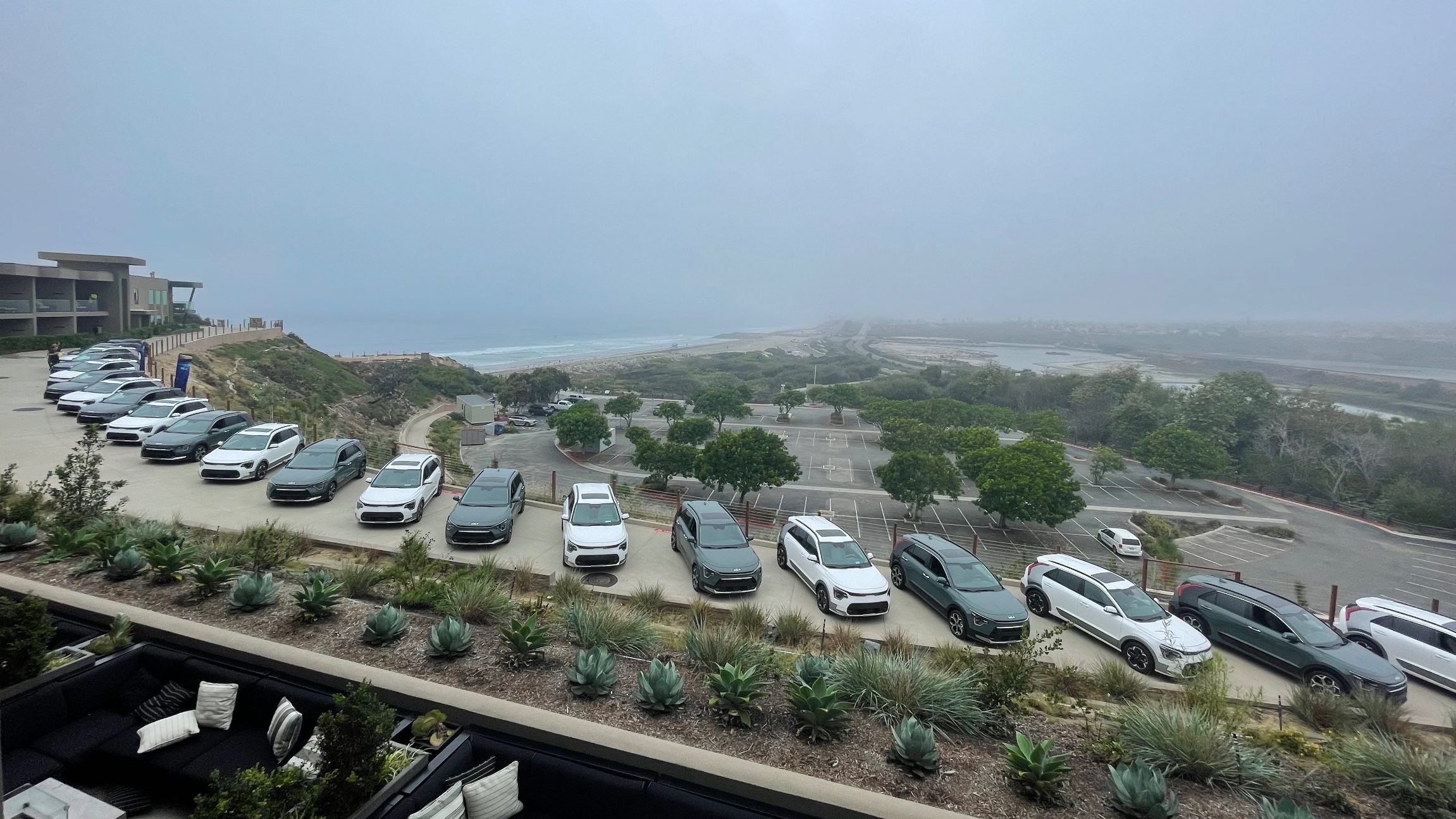
Comfort and practicality
The Kia Niro is roomy, with plenty of headroom and legroom. Kia says, compared to the RAV4, the Niro has “more” legroom (by half an inch) and “comparable” headroom. I had no problem sitting in the back seat when the front seat was adjusted for a 6′ driver, with multiple inches of space between my knees and the back of the seat.
The ride was comfortable, but not plush. 100% vegan materials have been used throughout the interior on the upgraded “Wave” trim, with some recycled materials as well. The headliner, for example, is made from recycled wallpaper.
Being an SUV, it also has a large trunk, and the rear seats fold down to give more space when needed.
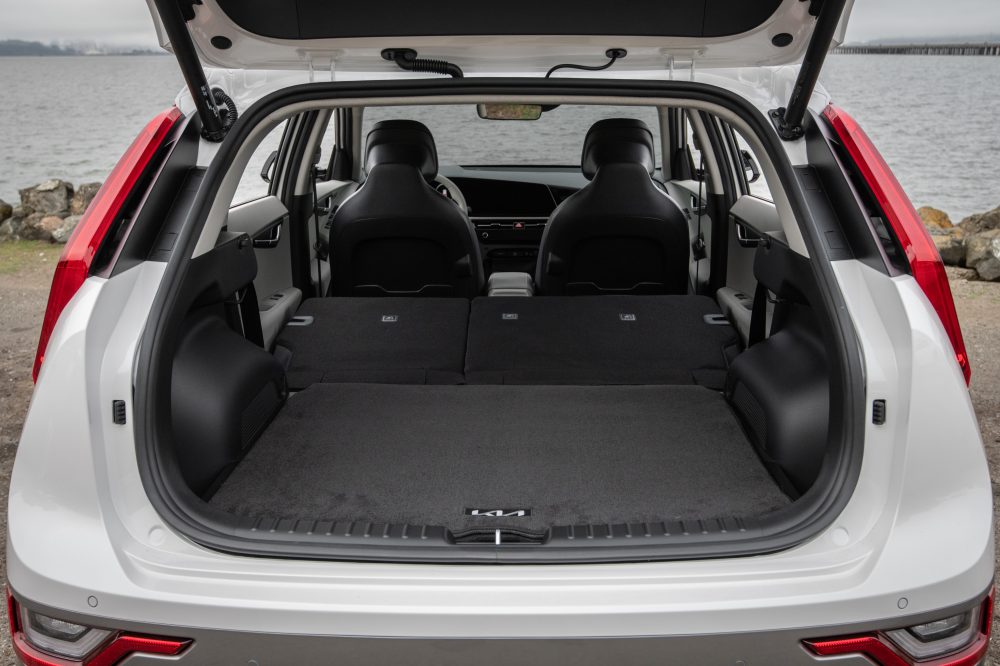
The rear cargo space is taller than the Kia EV6 with its sloping back, so the Niro should offer more functionality in that respect, if you’re looking to carry taller items. The 2023 Niro EV is 2.5 inches longer and .4 inches taller and wider than the 2022 model, so there’s a bit more space inside to go along with that additional heft outside.
The Niro EV does have a frunk, though it’s a little vestigial. Neither the HEV or PHEV models have frunks, as their engine compartments are full of… engine. The more compact EV drivetrain gives extra space, which the Niro EV fills with the same frunk unit as they use for the Kia EV6. It’s small, but a good place to store tools or charge connectors.
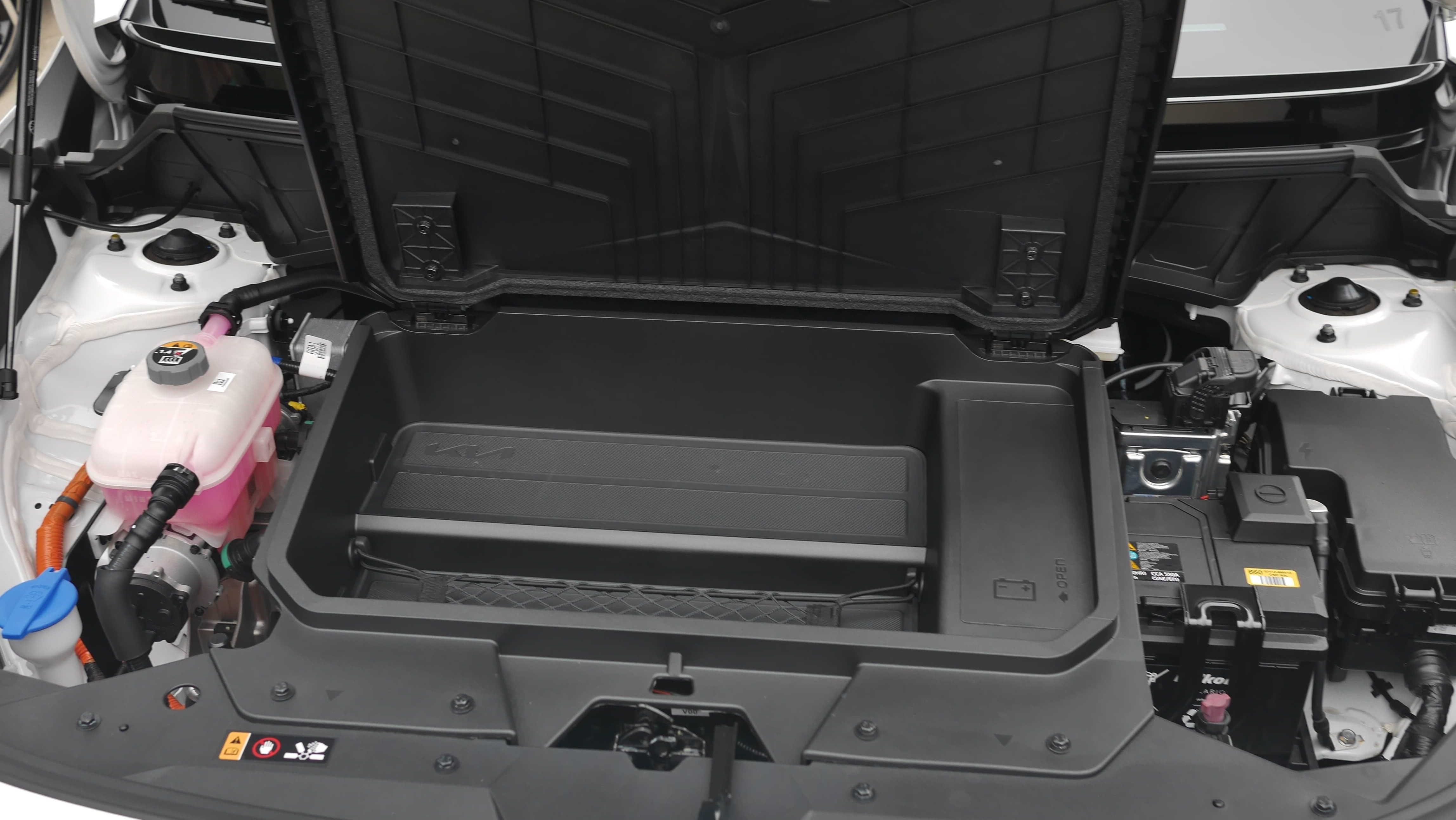
For cold weather folks, there is an optional heat pump and battery warmer. Cold environments can be a challenge for EVs, as electric motors and batteries are much more efficient and don’t produce as much waste heat. A heat pump is more efficient and can increase range by tens of miles in cold weather as compared to resistance heating, and the battery warmer can help to increase DC charge speeds for a cold battery, while increasing total state of charge by preconditioning the battery to be warm when charging.
There are also heated and optional ventilated seats, helping keep you comfortable in hot or cold weather. The ventilated seats worked well and immediately chilled me down on a warm Southern California day – so much so that I turned them off after only a minute or two, since they chilled me so well.
Efficiency and charging
The Niro EV comes equipped with a 64.8kWh battery rated at 253 miles range and a peak DC charge rate of 85kW, and an 11kW onboard AC charger.
Our efficiency during the drive fluctuated between 2.7 and 5.6 miles/kWh on the four “legs” of the drive program, in mixed driving conditions both on freeways and twisty mountain roads on a warm but not hot California day.
We drove a total of 154 miles, and were left with 75 miles of range on the car’s readout from an initial charge of ~250 miles, a 175-mile difference on the guess-o-meter (we started the day at just a little less than a 100% charge). So our real-world efficiency was a little lower than the car’s readout suggested.
We never get a chance to test quick charging on these drive events (though we did have lunch at a Tesla Supercharger location, if only we could use it…), so we can’t give you real-world charging results. The Niro’s peak DC charge rate of 85kW feels a little dated in 2022. While it isn’t the slowest charging car on the market, most EVs coming out these days are more in the neighborhood of 150kW, and the Kia EV6 even goes up to 225kW.
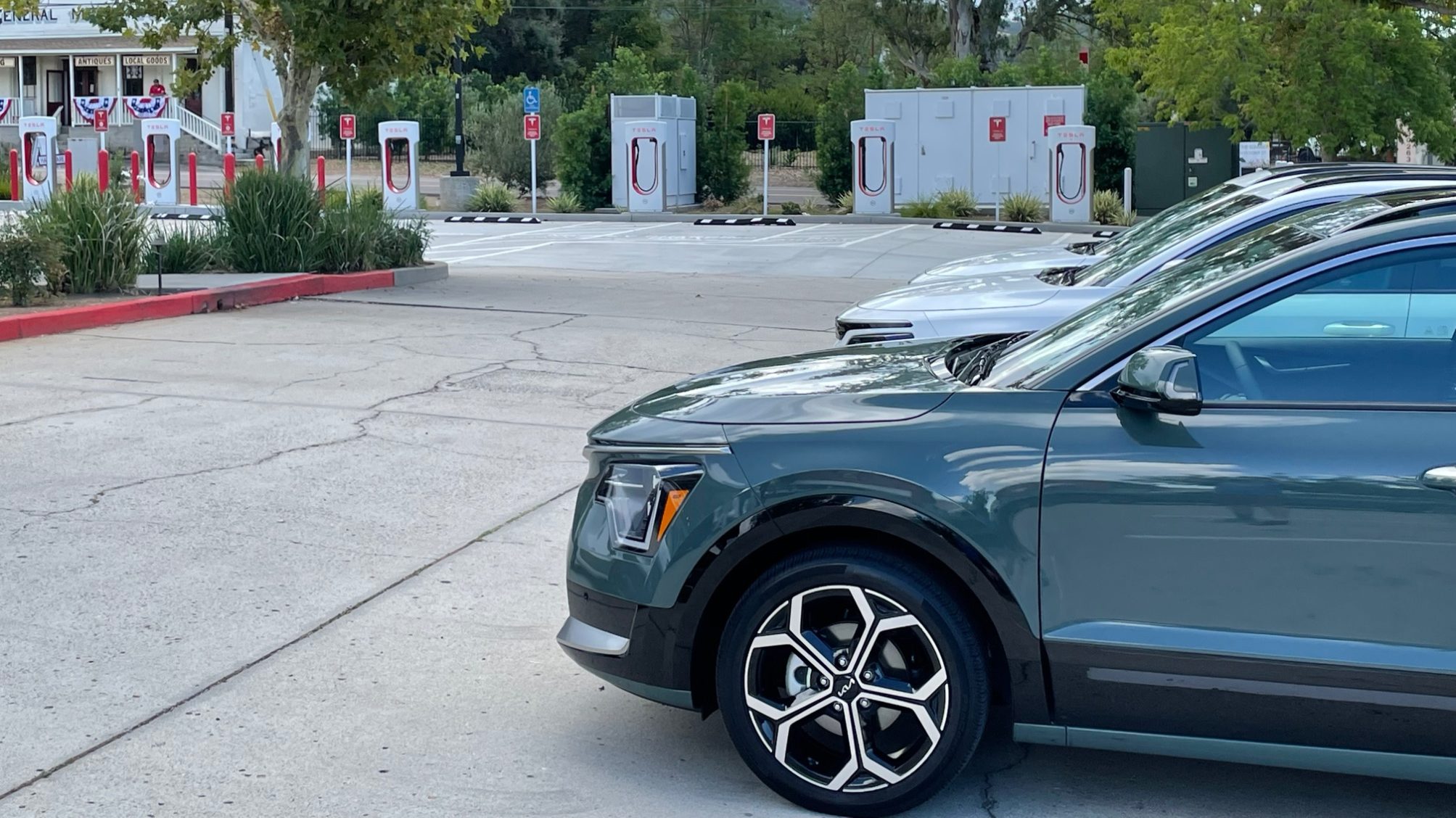
But the EV6 is built on Hyundai/Kia’s all-electric E-GMP platform, which is based on an 800V battery system that enables faster charging speed. Nevertheless, there are plenty of 400V cars with 150kW+ charging, so the Niro really ought to have a faster charging rate.
Nevertheless, Kia says that the Niro EV will charge to 80% in about 45 minutes. The car also comes with 500kWh of free charging on Electrify America’s network, enough for about 1,900 miles of driving. Kia says that one benefit of free charge credits is that they help encourage new EV owners to familiarize themselves with the DC charging experience and realize it’s easier than they might think.
That said, the DC charging experience won’t be as good as it could be. Between the relatively low 85kW charge rate, lack of “plug-and-charge” support (which lets you charge on EA without swiping a card), and ability to search for and route to charging stations but not route through them (by stating a destination and having the car plan charging stops for you), this car is not as perfect for roadtrips as the Tesla Model 3 is.
That’s a high bar to set, sure, but Kia could match it with effort – after all, the Kia EV6 (and Hyundai Ioniq 5, which shares a platform) can charge faster than any other car in practical use. So we really wish this car had a better charge rate and charge experience.
Finally, the Niro doesn’t come with a bundled 120v charge cable, which may irk some drivers. However, generic 120v charge cables are readily available at low cost, and Kia says they have “an accessory solution that will be even better” coming up (no word yet on what that might be).
Tech gizmos
The Niro EV’s coolest gizmo is somewhat charging-related – the optional “vehicle-to-load” (V2L) adapter which comes with the car’s top “Wave” trim, allowing you to access up to 1.8kW worth of power from the Niro’s charging port or rear trunk area. We’re not sure yet if that means it’s capable of 3.6kW of combined draw, or 1.8kW from each port, but basically you can plug in as much stuff as you could to any standard household outlet.
At the dinner after our drive, Kia displayed the car’s capabilities by using the V2L adapter to run the lights and audio equipment for our entertainment:
Since the drive event happened while Florida was being battered by one of the strongest hurricanes ever, Kia noted that a V2L adapter could also be used to run crucial household items if the power was out. A fully-charged Niro EV could conceivably power a refrigerator for weeks while the power is out.
And, of course, it is important to remember driving electric makes fewer transportation climate emissions, which are known to increase the severity of extreme weather events like hurricanes – the Niro EV helps on the front end and the back end in that respect.
The available HUD was bright and detailed, showing information on speed, speed limit, directions, nearby cars and status of the car’s driver assist systems. It’s probably the most informative HUD I’ve used yet.
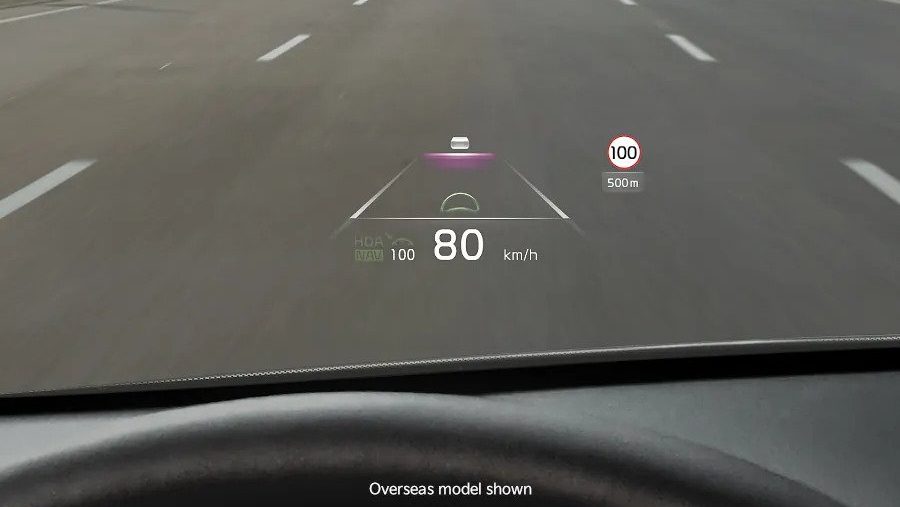
Kia’s “Drive Wise Intelligent Driver Assist System” was a little confusing to activate at first. An owner would surely have an easy time figuring out and getting used to it, but trying to figure it out live while driving the car was a little less easy than it should be.
We didn’t try activating the system on anything other than highway roads, where traffic-aware cruise control and lane keeping both worked well. The inputs were smooth to the point that sometimes it was not immediately obvious whether it was activated. But your mileage may vary here – Kia says the optional “Highway Drive Assist II” system will use machine learning to copy your driving style over time (follow distance, speed, reaction time), so that it will feel more natural to you.
The Niro has a full suite of other driver assist features, including driver attention warning, blind spot and cross traffic warnings, rear occupant alert so you don’t leave a kid in the car, and safe exit warning so you don’t door a cyclist when exiting the vehicle.
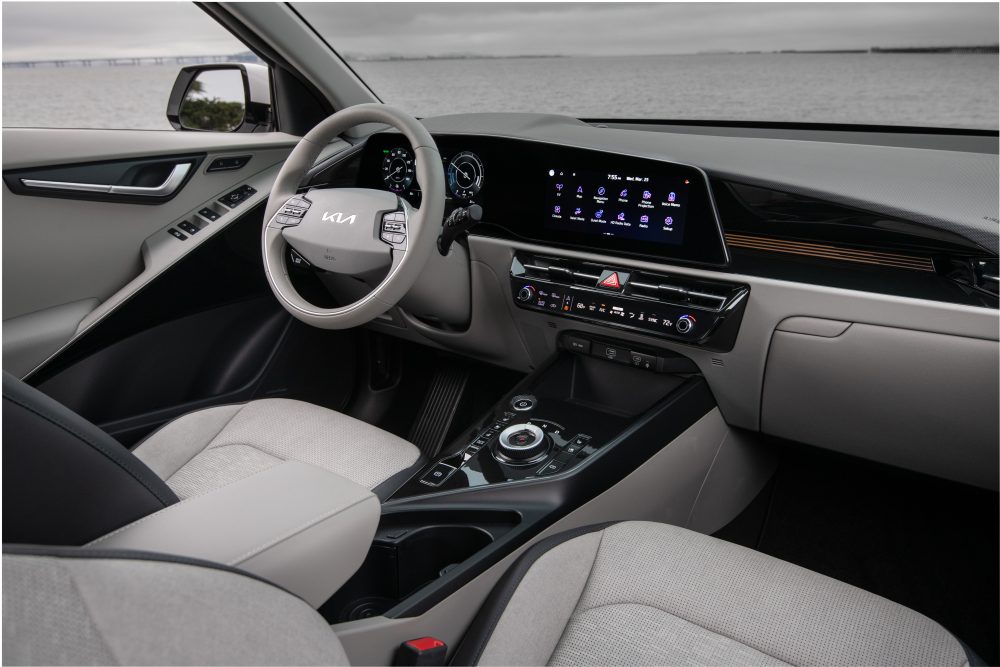
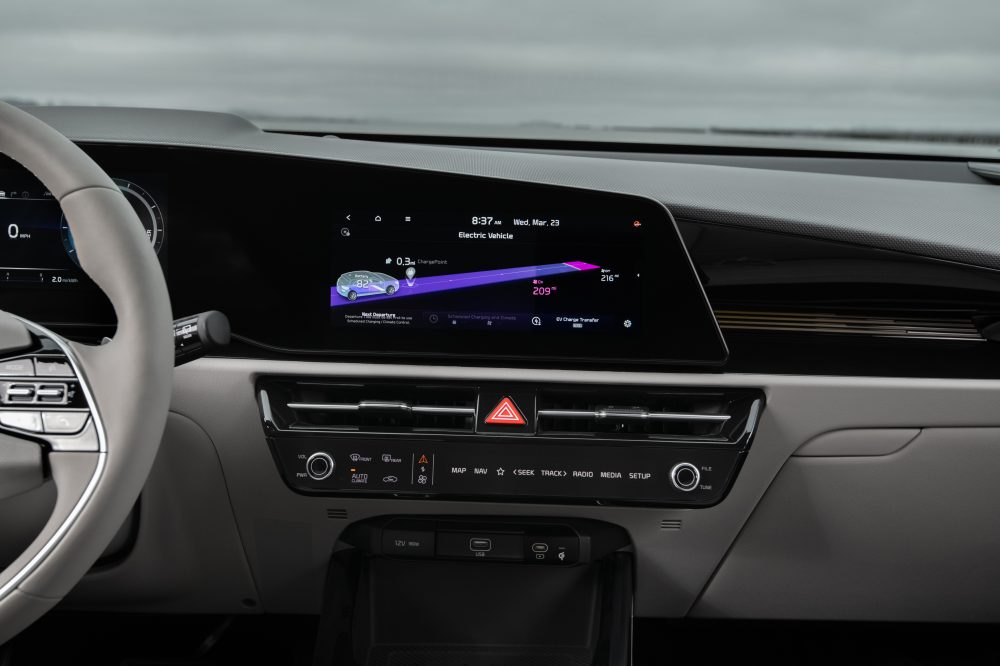
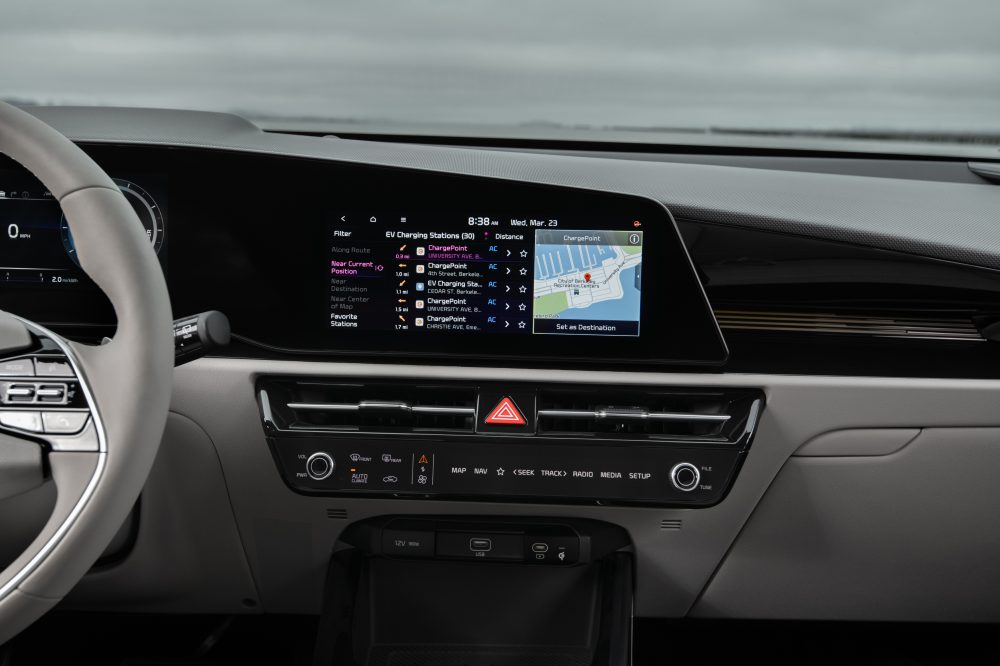
The infotainment system is acceptable and can receive over-the-air updates, but most people will spend their time in Carplay or Android Auto, which the car supports. It has an optional wireless charging pad under the center screen, and USB ports in the front seatbacks come standard. The steering wheel is full of an abundance of buttons and switches, with more buttons on the center console for seat climate settings, and the dials and touch control surface under the center screen serve dual purpose as climate and nav/media controls.
One final feature we didn’t get to test was Kia’s “Digital Key 2.0,” which allows you to use an iPhone, Apple Watch or Samsung Galaxy phone as a key. This means you can leave the key fob at home – one less thing in your pocket – and you can even share access with other phones by sending a text message with a temporary access key. Personally, I love using my phone as a key, so this is a great feature which I wish I could have tested.
Performance/Drive experience
Let’s be honest, people aren’t buying a Kia Niro EV for performance. The car does what it needs to do, but its 204hp (150kW) front-wheel drive motor is not going to blow any minds (though it’s more powerful than both the HEV and PHEV versions of the car).
That said, EVs naturally have performance benefits over ICE cars which just make them more pleasant to drive (unless the automaker deliberately cripples them), and the Niro does exhibit these benefits. In their presentation, Kia said “people are starting to discover that EVs are fun to drive” – I’d argue that people “started” discovering that more than a decade ago, but, I guess I’m ahead of the curve.
One thing about (most) EVs is that they have very good pedal response – there’s not a lot of delay between when you press the pedal and when the car starts delivering power. This is what makes even slower EVs “feel” so quick, and makes things like lane changes so much easier in them. The Niro EV displays this good pedal response, and feels peppy as you would expect.
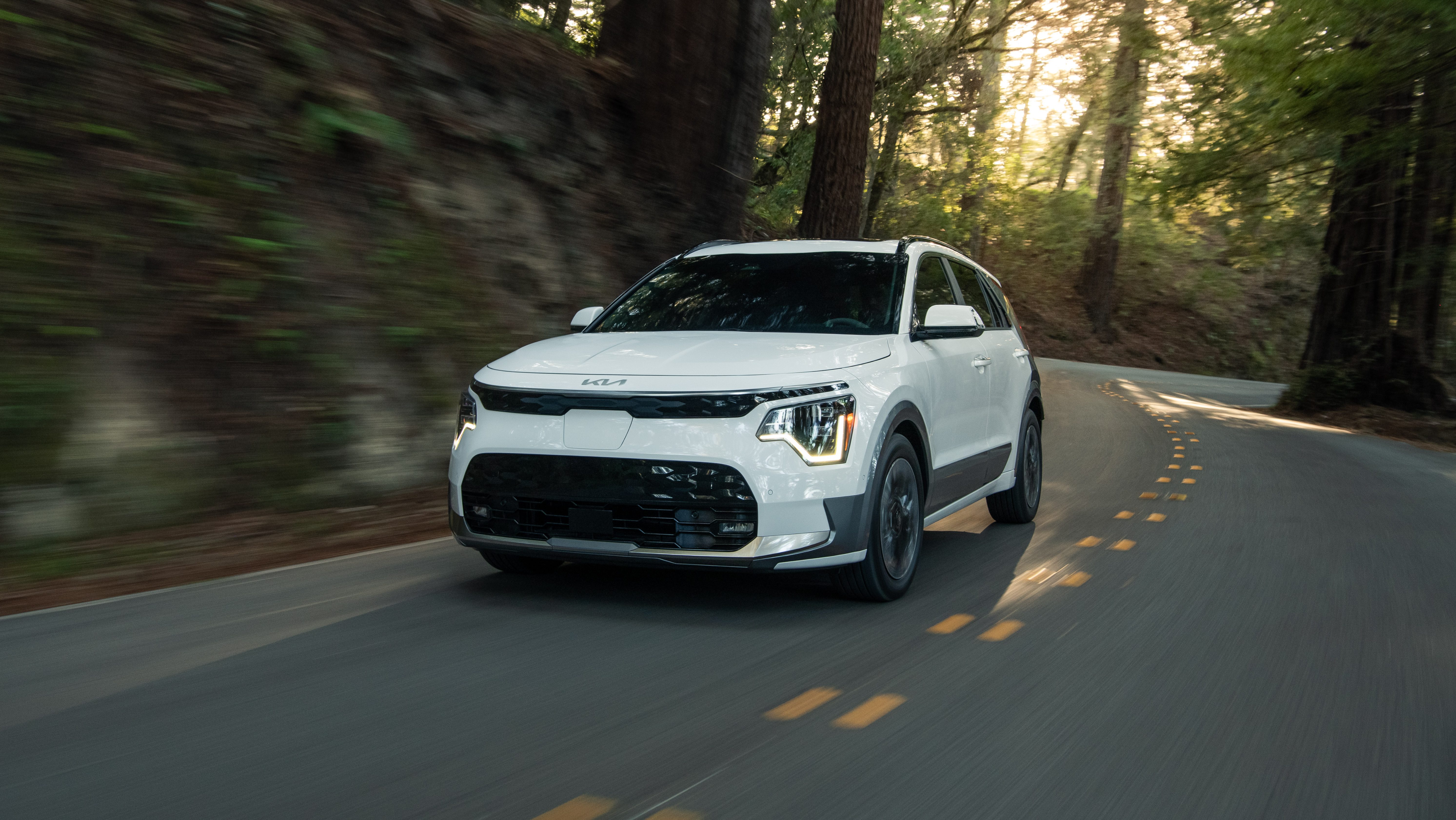
0-60 comes in about 7-8 seconds, which is on the low end for electric cars (but you can’t expect too much better from front-wheel drive vehicles). In practice, even at highway speeds the car still accelerated with confidence. It’s not throwing anyone back in the seats, but it has as much power as one needs for normal driving situations. Ride quality is smooth even beyond typical highway speeds, and this smoothness made it easy to accidentally find yourself driving faster than you thought you were driving (whoops).
The Niro EV also has very good regenerative braking. Levels can be adjusted with paddles on the back of the steering wheel, though I typically just set the regen to the maximum level and leave it there. One-pedal driving is possible in “i-Pedal” mode, though the car won’t remember that you’re in i-Pedal mode between driving sessions, so you need to press the paddle every time. Far too many cars do this – come on Kia and other automakers, you need to remember this setting, it’s almost a safety issue if you don’t (if you’re expecting the car to come to a complete stop and it doesn’t). We hope they’ll update the software to remember this setting.
There are three drive modes available with a button at the bottom of the steering wheel. These seem to only affect throttle mapping and the graphics on the display screen, as far as I could tell, which makes them somewhat superfluous.
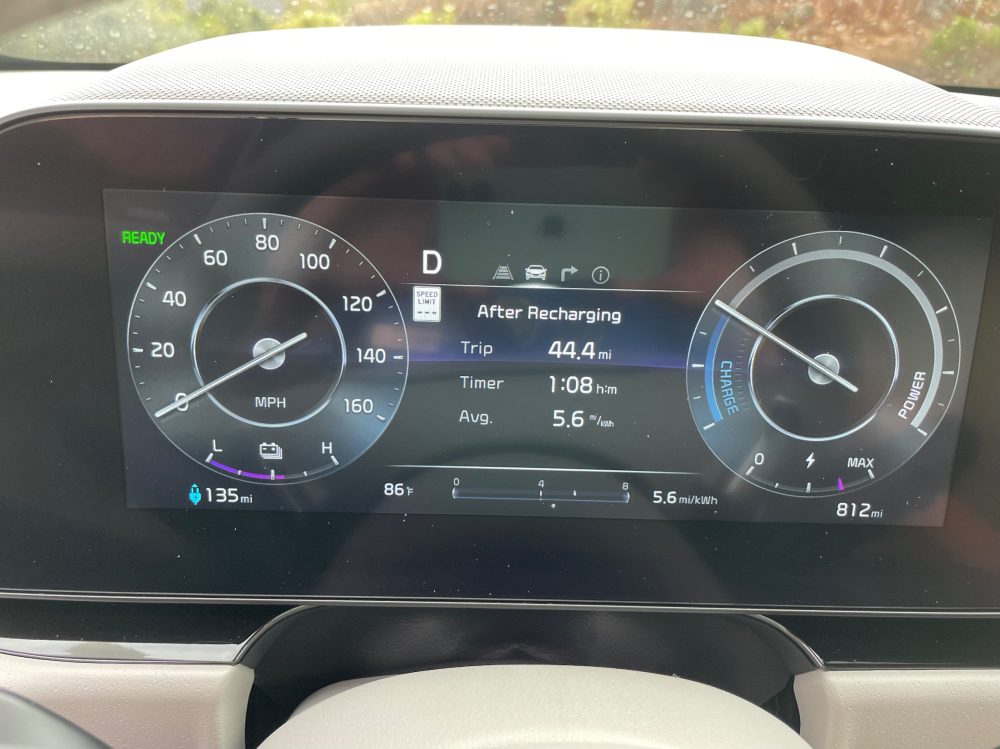
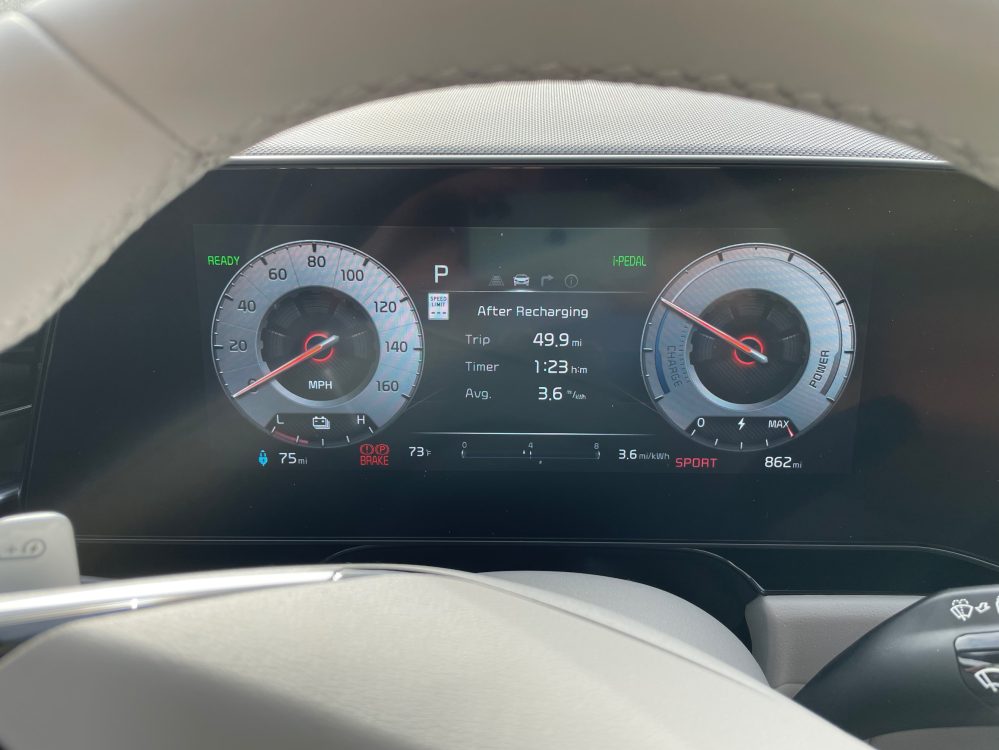
In general, drive modes that only affect throttle mapping don’t really do anything, and I’d rather have access to the full range of throttle in one default mode – then, if I want to drive “eco” I can just lift my foot a little, and if i want to drive “sport,” I just push my foot down more. The other problem is that the “sport” throttle makes acceleration stronger, and “eco” mapping makes regen stronger, but there’s no mode that gives me both. Why can’t I have the strongest acceleration and strongest regen at the same time?
As for handling, it’s an SUV, and handles like one. It’s a little wobblier than I’ve felt with other EVs, even the “sporty SUV” types of EVs, but not in any offensive way, just a little less “tight” than I’d like.
Value?
Well, here’s the big question: Is it worth it? And the answer is: We don’t know.
Kia has announced pricing for the HEV ($26,490 base, and $34,790 for the “SX Touring” upgraded trim) and PHEV ($33,740 base, $39,490 for SX Touring), but has not yet announced pricing for the 2023 Kia Niro EV model. And we don’t know when pricing will come, though we expect it will come “soon™.”
EV trims will be named “wind” for the base model and “wave” for the upgraded trim. We would expect to see about a ~$6k difference between these trims, in keeping with the price difference on the HEV and PHEV models.
The base price of Kia’s other EV, the EV6, is $41,400. On balance, given its feature set, we would consider it a better car, even with the base battery pack (232 miles, compared to the Niro’s 253). And Kia refers to the EV6 as their “halo” model, which is typically a more expensive model. So we would hope – and expect – that the Niro’s base price will be cheaper than this. I’d like to see it come in close to the price of the PHEV (after all, the EV has one engine, not two), in the mid-30s, and at that price, I would consider it a good value.
But the outgoing 2022 Kia e-Niro started at $39,990, not far off from the price of the EV6. And right now, we’re not seeing a lot of vehicles go down in price year over year. So if the 2023 Niro comes in at the high-30s or low-40s, there won’t be a lot to differentiate it from other electric SUVs in a similar price range – some of which come with significant government incentives (like the 2023 VW ID.4, which is assembled in the US and starts at $37k).
As for other comparisons to similar vehicles, these could be rough for the Niro. One of those cars that has gone down in price is the 2023 Chevy Bolt, which got a $6k price cut for 2023 and has a bonkers-low base MSRP of $25,600, and $27,200 for the 2023 Bolt EUV (which is comparable in size to the Niro EV, though the Bolt platform is feeling a little dated now).
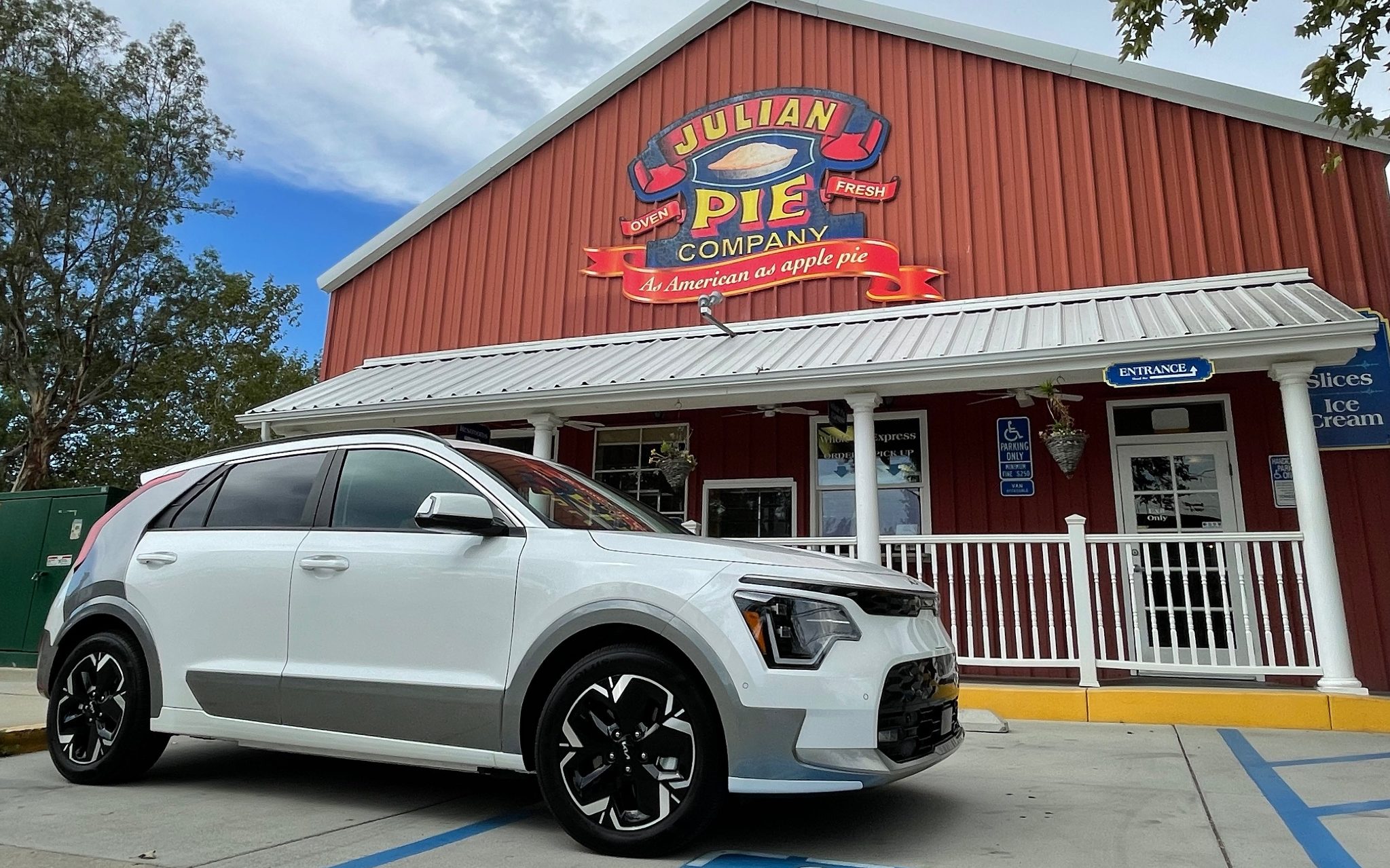
And next year, the Bolt will regain eligibility for the $7,500 US federal EV tax credit, which the Niro won’t qualify for due to changes made by the Inflation Reduction Act. These law changes are probably why Kia is late to announce pricing – foreign automakers had a wrench thrown in their works with the sudden revocation of credit eligibility.
But the Bolt is a bit of an outlier. Other electric SUVs tend to be priced higher, and if the Niro ends up being priced in the mid-high 30s, it will still be competitive with those cars. And as an EV, it’s going to be cheaper to run and more pleasant to drive and own than competing gas SUVs, and there’s certainly plenty of anonymous gas SUVs that sell for the mid-30s which the Niro EV would improve on the experience of.
The calculation against gas SUVs will become even more favorable if Kia manages to regain access to EV tax credits. Kia is reportedly accelerating plans to manufacture EVs in the US, but that will happen in 2024 at the earliest. And Raphael Warnock, Senator for Georgia, the state where Kia has a manufacturing plant in the US, recently introduced a bill that would give manufacturers a “grace period” to still qualify for tax credits (though the fate of that bill relies heavily on the results of November’s election, and whether anti-EV and anti-environment forces are given control of Congress).
And of course you may be eligible for state or local EV incentives, so check those for your area.
However, right now, every EV is selling out due to extremely high demand coupled with supply challenges from COVID-19, and many EVs are getting dealer adjustments due to such high demand. So its hard to predict how Niro EV value will shake out in the short term, as it all comes down to whether you can find one, and what you can find.
Wrap-up
When I was first invited to this drive event, I was a bit puzzled. Kia has an outstanding EV in its EV6 – it looks good, it’s sporty, it charges faster than anything else out there, and it’s based on Kia and Hyundai’s shared all-electric E-GMP platform, which not only has produced phenomenal vehicles already, but looks like it will continue to with the upcoming EV9.
So keeping the Niro in the lineup seemed strange to me. Why keep a multi-powertrain vehicle when you’ve already got something better? In general, I find the best forward indicator of an EV’s quality is whether or not it’s on a dedicated platform – retrofits of gas models are often so-so, ground-up EVs generally perform better than everything else, and multi-powertrain platforms are often compromised by needing to build around three sets of packaging constraints, which may not be as good as specialized designs.
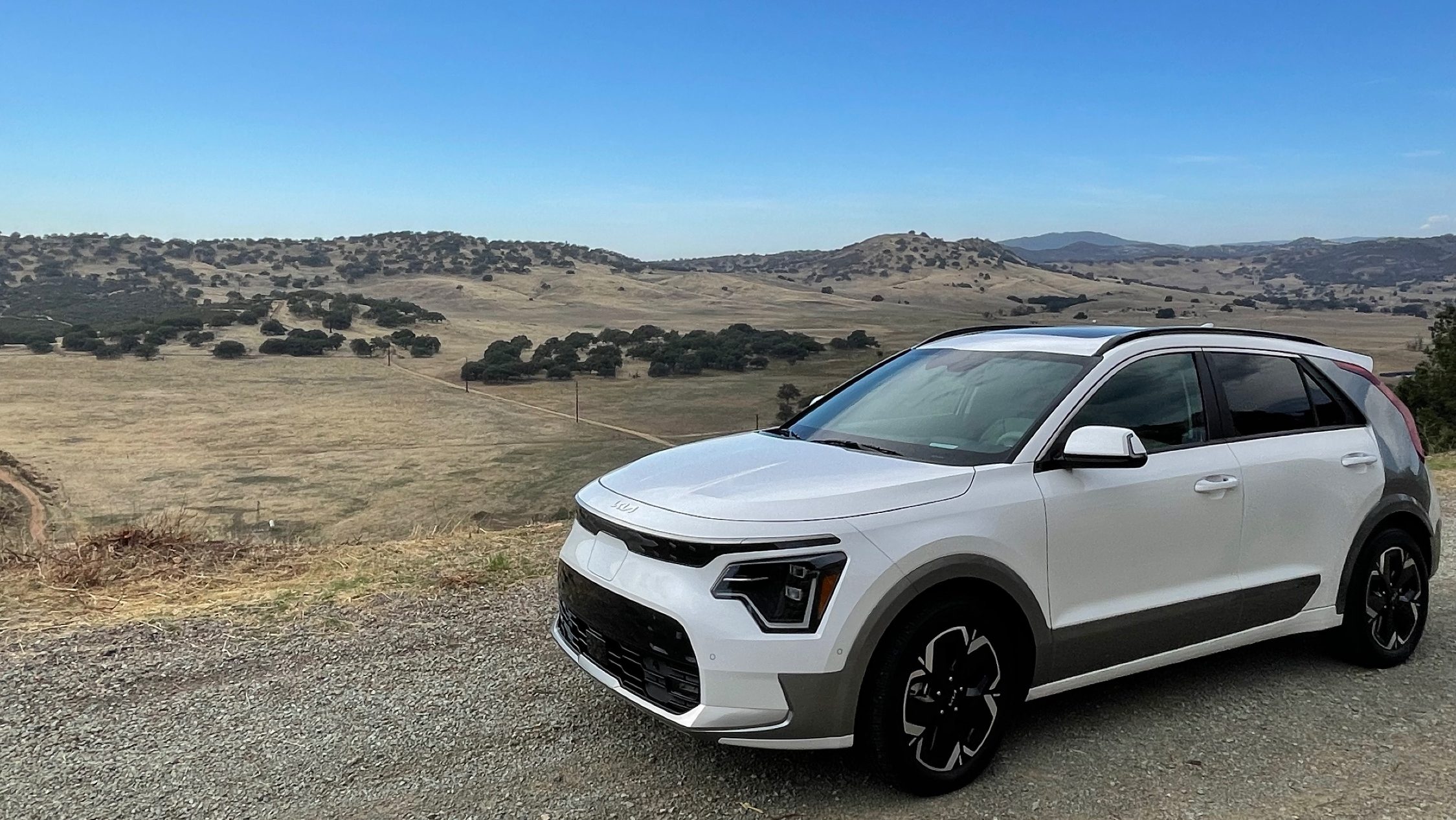
The K3 is a ground-up “electrified” platform, which was built with an EV in mind to begin with. So it’s not a huge compromise, but from Kia’s expected sales numbers (~2/3 hybrid sales), it’s apparent that the company will have to share significant focus and resources with a gas-powered vehicle. Even if the Kia employees we talked to, and the presentation we watched, did seem to recognize the EV as the “top” of the lineup, some compromises are unavoidable when more than half the cars in the lineup have a tailpipe (for example: listing “Exhaust System: Single muffler” in the spec sheet for the electric version… ).
That said, Kia/Hyundai are the only automakers that have done a good job with multi-powertrain platforms, in my opinion. And since Kia has a reasonable amount of experience with multi-powertrain EVs, this has given the opportunity to iron out some of the kinks that might have been present in a first-generation EV.
And in this respect, the Niro EV does seem to build on that trend. It’s a competent electric car that doesn’t feel like it’s “missing” anything big, or that it made any decisions to compromise its ability as an EV.
But it still didn’t blow me away, it didn’t have that je ne sais quoi that makes a really fantastic EV like the Tesla Model 3, Rivian R1T or Hyundai Ioniq 5 (and its EV6 cousin) stand out. It did feel like a continuation of the previous e-Niro – a good solid vehicle for people who want a good solid vehicle that won’t surprise them in any particular way. Kia called the EV6 their “emotional” halo EV, and the Niro their “intelligent” EV in their presentation materials.
In the end, the Niro EV is a solid choice for its target audience. The Kia EV6 is a much more compelling package, but it’s higher in price (?), has less cargo space, and is a bolder choice/statement than some might want to make with their car. The Niro EV has the benefit of being made by a relatively experienced EV automaker (at this point), being hopefully cheaper than the EV6 (put a pin in that…), and feeling a bit more “normal.” Normal isn’t for me, but it might be for you, and if it is, then this is probably one of the better choices you could get – depending on the price.
If you’re interested in the 2023 Kia Niro EV click here to find a local dealer and ask them to add you to their list of interested buyers. The 2023 isn’t out yet (so that link leads to the 2022 currently), but it will ship soon™
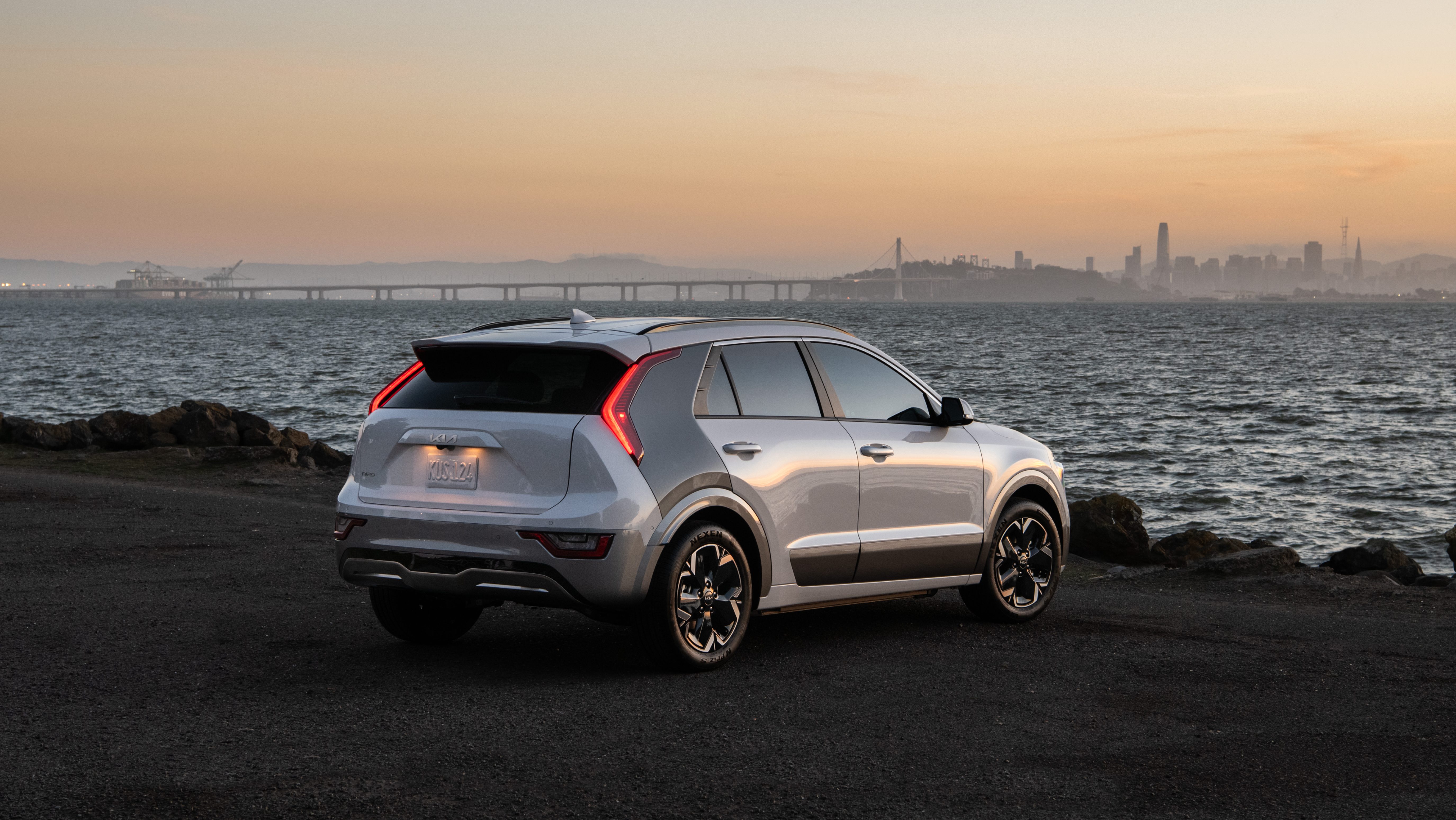
Subscribe to Electrek on YouTube for exclusive videos and subscribe to the podcast.
Author: Jameson Dow
Source: Electrek



